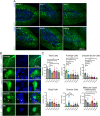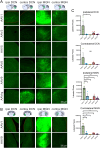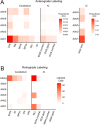Comparative Analysis of Six Adeno-Associated Viral Vector Serotypes in Mouse Inferior Colliculus and Cerebellum
- PMID: 39467650
- PMCID: PMC11576142
- DOI: 10.1523/ENEURO.0391-24.2024
Comparative Analysis of Six Adeno-Associated Viral Vector Serotypes in Mouse Inferior Colliculus and Cerebellum
Abstract
Adeno-associated viral vector (AAV) serotypes vary in how effectively they express genes across different cell types and brain regions. Here we report a systematic comparison of the AAV serotypes 1, 2, 5, 8, 9, and the directed evolution derived AAVrg, in the inferior colliculus (IC) and cerebellum. The AAVs were identical apart from their different serotypes, each having a synapsin promotor and expressing GFP (AAV-hSyn-GFP). Identical titers and volumes were injected into the IC and cerebellum of adult male and female mice, and brains were sectioned and imaged 2 weeks later. Transduction efficacy, anterograde labeling of axonal projections, and retrograde labeling of somata were characterized and compared across serotypes. Cell-type tropism was assessed by analyzing the morphology of the GFP-labeled neurons in the cerebellar cortex. In both the cerebellum and IC, AAV1 expressed GFP in more cells, labeled a larger volume, and produced significantly brighter labeling than all other serotypes, indicating superior transgene expression. AAV1 labeled more Purkinje cells, unipolar brush cells, and molecular layer interneurons than the other serotypes, while AAV2 labeled a greater number of granule cells. These results provide guidelines for the use of AAVs as gene delivery tools in these regions.
Keywords: adeno-associated virus; cerebellum; inferior colliculus.
Copyright © 2024 Witteveen and Balmer.
Conflict of interest statement
The authors declare no competing financial interests.
Figures









Update of
-
Comparative analysis of six adeno-associated viral vector serotypes in mouse inferior colliculus and cerebellum.bioRxiv [Preprint]. 2024 Oct 21:2024.10.17.618966. doi: 10.1101/2024.10.17.618966. bioRxiv. 2024. Update in: eNeuro. 2024 Nov 4;11(11):ENEURO.0391-24.2024. doi: 10.1523/ENEURO.0391-24.2024. PMID: 39484622 Free PMC article. Updated. Preprint.
Similar articles
-
Comparative analysis of six adeno-associated viral vector serotypes in mouse inferior colliculus and cerebellum.bioRxiv [Preprint]. 2024 Oct 21:2024.10.17.618966. doi: 10.1101/2024.10.17.618966. bioRxiv. 2024. Update in: eNeuro. 2024 Nov 4;11(11):ENEURO.0391-24.2024. doi: 10.1523/ENEURO.0391-24.2024. PMID: 39484622 Free PMC article. Updated. Preprint.
-
Cellular selectivity of AAV serotypes for gene delivery in neurons and astrocytes by neonatal intracerebroventricular injection.PLoS One. 2017 Dec 15;12(12):e0188830. doi: 10.1371/journal.pone.0188830. eCollection 2017. PLoS One. 2017. PMID: 29244806 Free PMC article.
-
[Expression pattern of different serotypes of adeno-associated viral vectors in mouse retina].Beijing Da Xue Xue Bao Yi Xue Ban. 2020 Oct 18;52(5):845-850. doi: 10.19723/j.issn.1671-167X.2020.05.008. Beijing Da Xue Xue Bao Yi Xue Ban. 2020. PMID: 33047717 Free PMC article. Chinese.
-
Adeno-associated virus vectors serotyped with AAV8 capsid are more efficient than AAV-1 or -2 serotypes for widespread gene delivery to the neonatal mouse brain.Neuroscience. 2006;138(2):501-10. doi: 10.1016/j.neuroscience.2005.11.057. Epub 2006 Jan 18. Neuroscience. 2006. PMID: 16414198
-
Tropism of adeno-associated virus serotypes in mouse lungs via intratracheal instillation.Virol J. 2024 Nov 25;21(1):302. doi: 10.1186/s12985-024-02575-9. Virol J. 2024. PMID: 39581991 Free PMC article.
Cited by
-
Intracerebellar upregulation of Rheb(S16H) ameliorates motor dysfunction in mice with SCA2.Acta Pharmacol Sin. 2025 Jul;46(7):1852-1863. doi: 10.1038/s41401-025-01504-y. Epub 2025 Mar 3. Acta Pharmacol Sin. 2025. PMID: 40033054
References
Publication types
MeSH terms
Substances
Grants and funding
LinkOut - more resources
Full Text Sources
